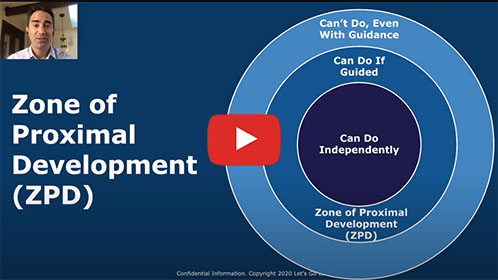Efforts to find the best way to teach students involve many personalized learning strategies. One such strategy is to determine the “zone of proximal development.”
The zone of proximal development is the sweet spot for personalized learning, where the subjects and rigor are ideally suited to an individual student’s optimal learning. Ideally, this is the point where the new knowledge is not too confusing, but also not so easy.
This concept comes from the work of a Russian psychologist 100 years ago named Lev Vygotsky. Towards the end of a life that was tragically cut short by tuberculosis at age 37, Vygotsky postulated and coined the phrase “zone of proximal development.” Vygotsky was interested in improving child development, and along with the zone of proximal development, he recognized the importance of culture-specific tools and social collaboration.
Learn more about summer school today!
“The zone of proximal development is the sweet spot for personalized learning, where the subjects and rigor are ideally suited to an individual student’s optimal learning.”
Since Vygotsky’s death, many child development and education experts have adapted and expanded his initial ideas into education to provide a better understanding of personalized learning. Viewed simply, a student’s current state of knowledge can be divided into three stages:
- What the student already knows
- Zone of proximal development: what the student can readily learn with the help of a tutor
- What the student cannot yet learn
The first stage represents knowledge the student can already work with independently and comfortably. The second stage represents the zone of proximal development, or the ideal level of new content a student can learn with the help of a subject matter expert and culturally appropriate tools. This expert can be a teacher, a parent, another student who has already advanced in the subject, or in today’s world, technology that offers guidance. The zone of proximal development is the ideal place to teach new knowledge to students, allowing them to comprehend the subject matter, thrive, and then develop their own expertise and higher-level thinking. The third stage represents the knowledge that is currently beyond the reach of the student’s comprehension, even with the help of a mentor.
Automatic, personalized learning
To make learning appropriate and worthwhile, parents and teachers need to target the right level of instruction so that they can find the zone of proximal development. The best way to do this is to assess a student’s level of knowledge and understanding before teaching begins, and to continue assessing periodically to make sure the student is on track with what is being taught.
Let’s Go Learn provides diagnostic assessments that do just that. Here is a 5-minute video that explains more about the zone of proximal development and how Let’s Go Learn’s assessments help you find the ideal level of instruction for personalized learning.



Leave A Comment